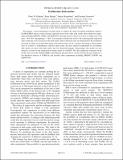| dc.contributor.author | Graham, Peter W. | |
| dc.contributor.author | Harnik, Roni | |
| dc.contributor.author | Rajendran, Surjeet | |
| dc.contributor.author | Saraswat, Prashant | |
| dc.date.accessioned | 2011-01-07T14:03:09Z | |
| dc.date.available | 2011-01-07T14:03:09Z | |
| dc.date.issued | 2010-09 | |
| dc.date.submitted | 2010-06 | |
| dc.identifier.issn | 1550-2368 | |
| dc.identifier.issn | 1550-7998 | |
| dc.identifier.uri | http://hdl.handle.net/1721.1/60391 | |
| dc.description.abstract | We propose a novel mechanism for dark matter to explain the observed annual modulation signal at DAMA/LIBRA which avoids existing constraints from every other dark matter direct detection experiment including CRESST, CDMS, and XENON10. The dark matter consists of at least two light states with mass ~few GeV and splittings ~5 keV. It is natural for the heavier states to be cosmologically long-lived and to make up an O(1) fraction of the dark matter. Direct detection rates are dominated by the exothermic reactions in which an excited dark matter state downscatters off of a nucleus, becoming a lower energy state. In contrast to (endothermic) inelastic dark matter, the most sensitive experiments for exothermic dark matter are those with light nuclei and low threshold energies. Interestingly, this model can also naturally account for the observed low-energy events at CoGeNT. The only significant constraint on the model arises from the DAMA/LIBRA unmodulated spectrum but it can be tested in the near future by a low-threshold analysis of CDMS-Si and possibly other experiments including CRESST, COUPP, and XENON100. | en_US |
| dc.description.sponsorship | United States. Dept. of Energy. Office of Nuclear Physics (Grant No. DE-FG02-94ER40818) | en_US |
| dc.description.sponsorship | National Science Foundation (U.S.) (Grant No. PHY-0600465) | en_US |
| dc.description.sponsorship | National Science Foundation (U.S.) (Grant No. 0756174) | en_US |
| dc.description.sponsorship | Stanford Institute for Theoretical Physics | en_US |
| dc.language.iso | en_US | |
| dc.publisher | American Physical Society | en_US |
| dc.relation.isversionof | http://dx.doi.org/10.1103/PhysRevD.82.063512 | en_US |
| dc.rights | Article is made available in accordance with the publisher's policy and may be subject to US copyright law. Please refer to the publisher's site for terms of use. | en_US |
| dc.source | APS | en_US |
| dc.title | Exothermic dark matter | en_US |
| dc.type | Article | en_US |
| dc.identifier.citation | Graham, Peter W. et al. "Exothermic dark matter." Physical Review D 82.6 (2010):063512. © 2010 The American Physical Society | en_US |
| dc.contributor.department | Massachusetts Institute of Technology. Center for Theoretical Physics | en_US |
| dc.contributor.department | Massachusetts Institute of Technology. Department of Physics | en_US |
| dc.contributor.approver | Rajendran, Surjeet | |
| dc.contributor.mitauthor | Rajendran, Surjeet | |
| dc.relation.journal | Physical Review D | en_US |
| dc.eprint.version | Final published version | en_US |
| dc.type.uri | http://purl.org/eprint/type/JournalArticle | en_US |
| eprint.status | http://purl.org/eprint/status/PeerReviewed | en_US |
| dspace.orderedauthors | Graham, Peter; Harnik, Roni; Rajendran, Surjeet; Saraswat, Prashant | en |
| mit.license | PUBLISHER_POLICY | en_US |
| mit.metadata.status | Complete | |
